Exercises (62)
squat
Coordination exercises
Individual work
Standing upright, place the front foot straight and the back foot with the forefoot on the slackline (about one foot length apart). In this position, bend your knees until you can sit with your buttocks on your heels.
Easier:
Perform the exercise close to the attachment.
Harder:
Touch the slackline with one hand (line grab); stand up again from the squat, take a step forwards and squat down again (other forefoot).
1 Slackline
Juggler
Coordination exercises
Individual work
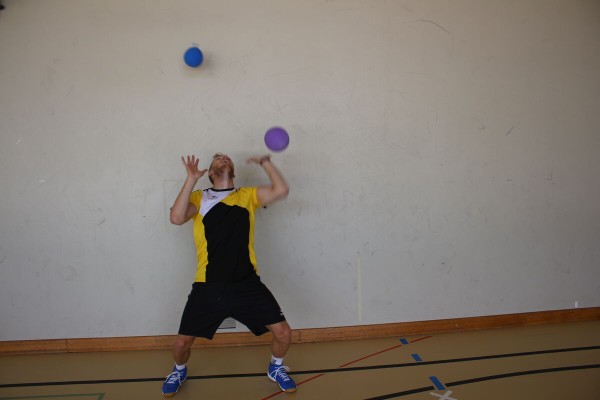
Hold two, three or more balloons in the air at the same time by flapping them with your hands without one balloon falling to the ground.
Variant I:
Hold balloons or balls/shuttles in the air with a tennis or badminton racket.
Variant II:
Hold juggling scarves in the air by plucking them.
8 balloons
2 badminton/tennis rackets
4 badminton shuttles/balls
6 juggling cloths
Juggler
Coordination exercises
Individual work
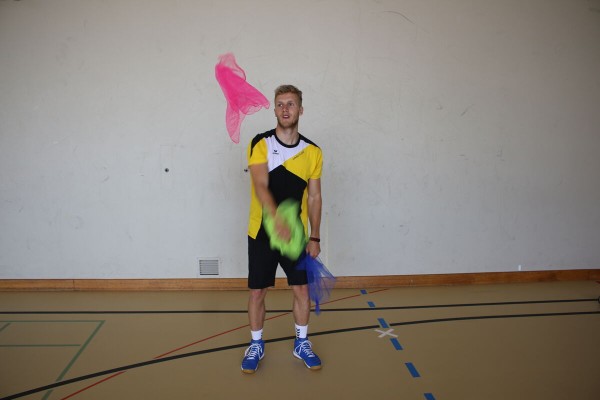
The participants try to juggle with different utensils:
- Juggling one-handed with 2 balls or two-handed with 3 balls (tennis balls, foam balls, floorball balls, possibly even frisbees). Also possible standing on a balancing board.
- Holding juggling scarves in the air.
- Holding a badminton shuttle with the racket in the air while sitting down and standing up. Perform half and full body rotations while juggling. The same exercise can be performed with the Indiaca.
- Throw the foam ball into the air or against a wall and catch it with the frisbee. Throw the foam ball to each other in pairs and catch it with the frisbee.
Make it easier:
Juggling can be practised on an inclined surface (e.g. door of the equipment room/garage door; small mats set up at an angle). The balls are not thrown straight up into the air, but onto the sloping surface. This gives the participant more time to learn the basic movement.
► Differentiation ability, rhythmisation ability, reaction ability
3 tennis/unihockey/smolball balls, throwing discs, juggling cloths
1 Indiaca
1 badminton racket incl. badminton shuttle
1 balance board
Door of the equipment room/garage door ►Facilitate the exercise
Kastensurfer
Coordination exercises
Individual work
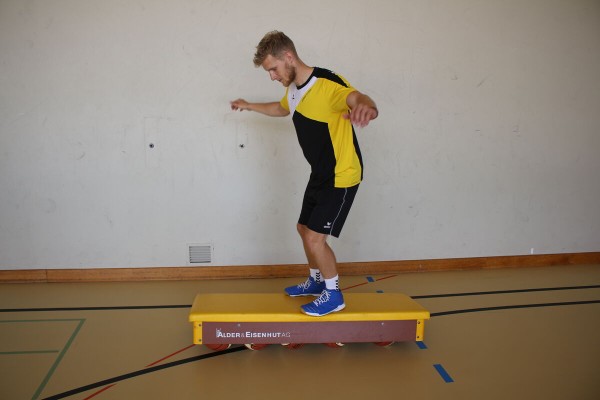
The participant tries to keep their balance while standing on the unstable box lid.
► Balance ability
1 vaulting box top
3-4 basket/medicine balls
Post structure:
One vaulting box top is placed on three to four medicine or basketballs
King of the line
Coordination exercises
Individual work
Two participants stand on the same slackline. The one who manages to stay up longer receives a point. Who has 5 wins first?
Easier:
Another participant sits in the centre of the slackline.
Easier:
The participants position themselves closer together in the centre of the slackline.
1 Slackline
Kneecap ► kneedrop
Coordination exercises
Individual work
Position your front foot straight and bend your leg. With your back leg, hook your shin onto the strap and try to push your knee under the slackline.
Lighten the load:
Perform the exercise close to the attachment.
Harden the load:
Touch the slackline with one hand (line grab); stand up again from the kneedrop position, take a step forwards and perform another kneedrop (different forefoot).
1 Slackline
Orientation artist
Coordination exercises
Partner work
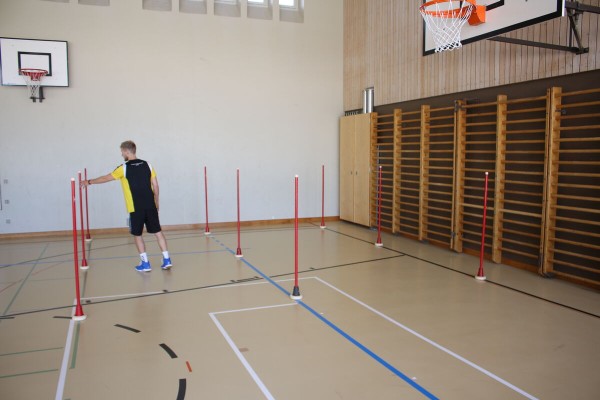
One participant gives their partner a route to run around the stakes to the opposite side. With their eyes closed, they try to run the specified route. After feedback on the execution of the exercise, the roles are swapped.
Variant:
Individual work: the participant imagines a route for themselves and tries to complete it with their eyes closed (blind route).
►Orientation skills
9 stakes
Post setup:
Place the stakes in a rectangle (3x3).
Passing game
Coordination exercises
Partner work
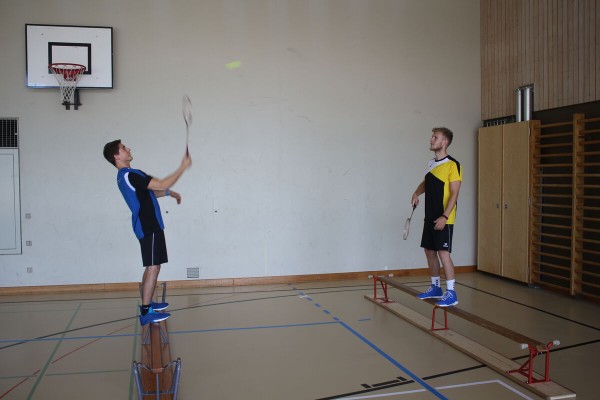
Two participants stand opposite each other on the thin side of a long bench at a distance of approx. 4-5 metres and play badminton (or Indiaca).
► Differentiation ability, orientation ability
Per group of 2:
2 badminton rackets
1 badminton shuttle
1 Indiaca
2 long benches
Post setup:
Place two long benches parallel to each other with a distance of approx. 4-5 metres and the narrow side facing upwards.
Passing game
Coordination exercises
Partner work
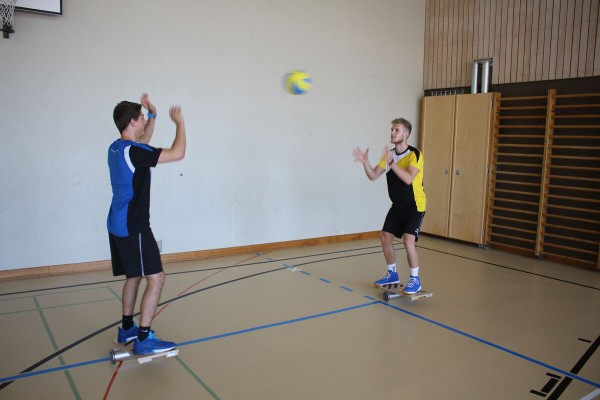
The participants stand approx. 3 metres apart and throw a volleyball at each other. Both participants stand on a medicine ball or a balance board and try to keep their balance. If the exercise is too difficult, the participants can support each other (hold/secure) and first try to stand reasonably safely on the medicine ball/balance board.
► Balance skills
2 balance boards/medicine balls
1 volleyball
Passing game
Coordination exercises
Partner work
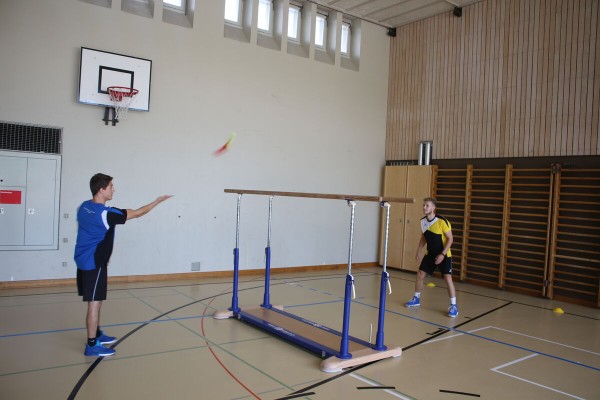
The participants pass an Indiaca to each other with the palms of their hands over the raised bar. They try to play right and left and keep the Indiaca in the air for as long as possible.
Variant:
Game (competition) for points.
► Differentiation ability, reaction ability
1 parallel bar
1 Indiaca
4 marking cones (optional) ►Playing field marking
Post set-up:
Fix the uprights of a parallel bar at a great height. Optionally mark a playing field around the bar using cones
Passing game
Coordination exercises
Partner work
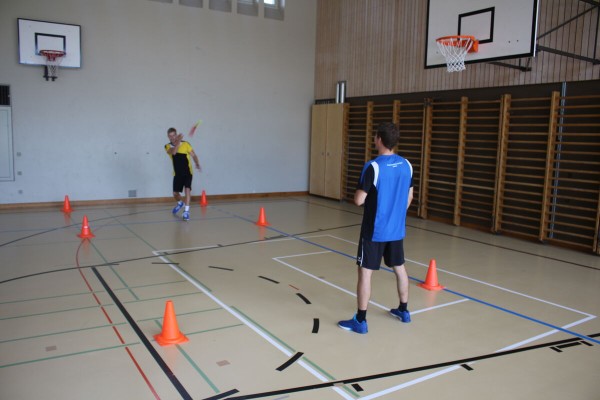
The participants stand opposite each other in two marked rectangles with a certain distance between the fields (approx. 4-5 metres for Indiaca/badminton; approx. 8-10 metres for speedminton). The participants play an Indiaca with the palms of their hands or a shuttle with their rackets. When playing with the Indiaca, participants try to play with the right and left. The aim is to keep the Indiaca/shuttle in the air for as long as possible.
Variant:
Game (competition) for points.
► Differentiation ability, reaction ability
8 marker cones/cups
1 Indiaca
Post set-up:
Mark out two playing fields using cones.
Passing game
Coordination exercises
Partner work
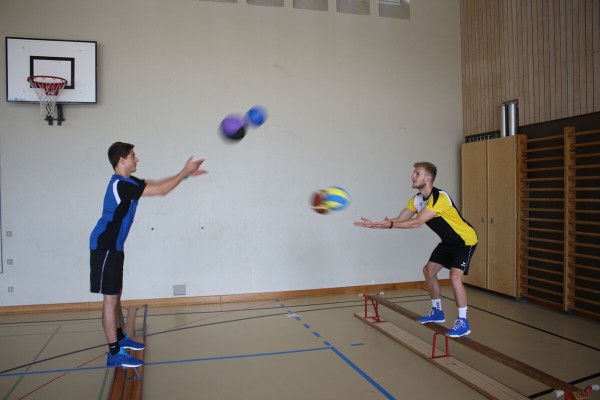
Two participants stand opposite each other on the narrow side of a long bench and pass two different balls to each other at the same time.
Variation:
Plays via the floor.
► Balance skills, differentiation skills
2 long benches
1 football
1 volleyball
1 softball
1 floorball
1 tennis ball
1 medicine ball
1 handball
1 lightning ball
Post setup:
Place two long benches parallel to each other with a distance of approx. 2-3 metres between them.
Passing game
Coordination exercises
Partner work
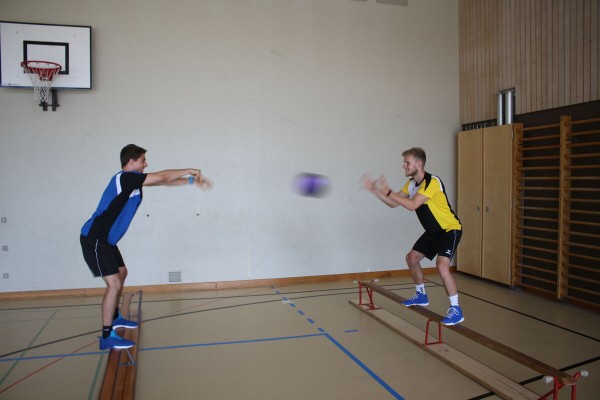
Two participants stand opposite each other on the narrow side of a long bench and try to unbalance their partner by throwing a medicine ball at them so that they have to leave the bench when they catch the ball.
► Balance skills
2 long benches
1 medicine ball
Post set-up:
Place two long benches parallel to each other at a distance of approx. 2-3 metres.
Cross stand
Coordination exercises
Individual work
Both feet point in the same direction, the gaze and shoulders are directed towards the end point of the slackline, the arms are at a 90 degree angle to the slackline (slalckline and arms form a '+' sign), feet at least hip-width apart, knees slightly bent.
Lighten the load:
Perform the exercise close to the attachment; stretch the slackline tightly over a short distance (3-5m); sit a partner in the middle of the slackline to dampen the initial trembling; help a partner by holding their hand (always go with the balancing movement and only stabilise if the slackliner is about to fall).
Make it harder:
Stretch the slackline over a long distance.
1 Slackline
Reaction trapping
Coordination exercises
Partner work
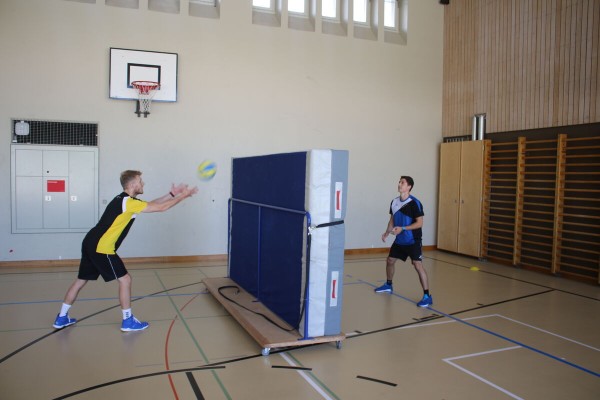
The participants throw a volleyball to each other over a thick mat into a field of approx. 5-6 metres defined by marker cones. To prevent an opponent scoring a point, the ball must be caught before it touches the ground. Throws that do not reach the playing field or get stuck on the mat result in a point for the opponent. Throws are only allowed from bottom to top.
► Reactivity
1 mat trolley (large; incl. mat)
1 volleyball
4 cones
Post setup:
The mat trolley serves as a boundary between the two halves of the playing field. The size of the playing field is marked with cones
Reaction trapping
Coordination exercises
Partner work

One participant sits on the floor with their back against the vaulting box. His legs are spread apart, his arms are held out in front of him and his gaze is fixed on a marker cone about 5-6 metres in front of him. The partner kneels/stands on the vaulting box and drops a foam/softball with their arms outstretched forwards. The seated participant tries to catch the ball before it falls to the floor. After a few attempts, the roles are swapped.
► Reactivity
1 vaulting box ► indoor version
1 marker cone/cap
1 foam/softball
Indoor set-up:
A marker cone/cap is located approximately 5-6 metres from the vaulting box.
Outdoor version:
Without vaulting box; the partner stands on the ground.
Reaction trapping
Coordination exercises
Partner work
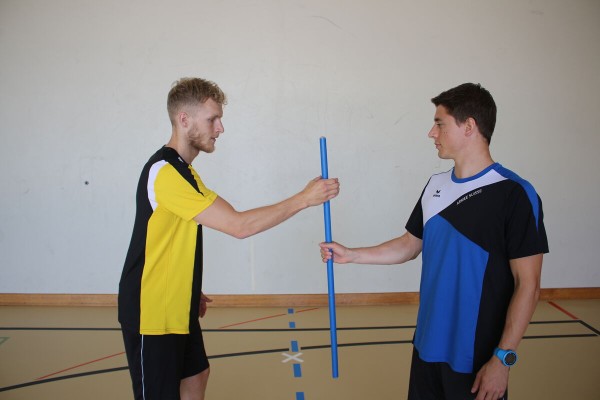
One participant supports themselves with their forearm on a vaulting box and holds their hand slightly open. His partner holds a stick (or floorball stick) in the opening of the active participant's hand (distance between palm and stick: approx. 1cm) with the end of the stick at the bottom edge of the hand. If the partner drops the stick, the active participant tries to catch it as quickly as possible.
Variant:
Perform the exercise simultaneously with both hands and one stick per hand. Only one stick is dropped at a time (choice reaction).
► Reactivity
1 vaulting box
1-2 (wooden) sticks or floorball sticks
Reaction pass game
Coordination exercises
Partner work

A participant stands on a pommel horse. He has his hands stretched out to the side and is holding a volleyball in each hand. The second participant stands approx. 1-2 metres in front of the pommel horse and throws another volleyball to the participant standing on the horse. If the pass goes to the head, the ball is passed back with the head. If the pass comes to the feet, the ball is passed back with the left or right foot (depending on the side of the pass). If the pass comes to one of the outstretched arms, the ball held in the hands must be passed to the partner and the new ball must be caught. The passer can make the exercise easier or more difficult by looking at where the pass is made or not. After a few attempts, the roles are swapped.
► Balance and reaction skills
1 pommel horse
3 volleyballs
Reaction pass game
Coordination exercises
Partner work
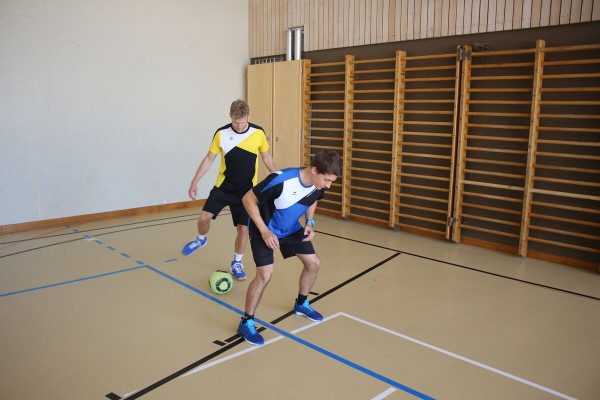
The participants stand behind each other, the participant at the back is equipped with a futsal/football. The person behind passes the ball to their partner from behind between their legs or throws it forwards over their partner's head. The partner must react as quickly as possible and intercept/stop the ball as early as possible. After a few attempts, the roles are reversed.
► Reactivity
1 Futsal/football
Tyre jumping
Coordination exercises
Individual work
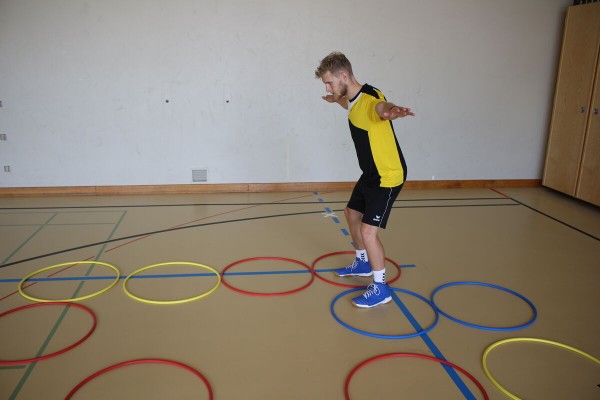
The participant hops over the tyres distributed on the floor. If two hoops are at the same height, both legs are used. Individual hoops are passed with the leg corresponding to the respective side. The hoops can be jumped through forwards or backwards. To make hoop jumping more difficult, the respective arm on the same or even opposite side can be lifted or stretched to the side at the same time when standing.
► Rhythmisation ability, orientation ability, balance ability
20-30 tyres
Post set-up:
Lay out the tyres to form a jumping course.
Supine position
Coordination exercises
Individual work
Back position on the slackline. Place one foot on the line close to the buttocks and use the other leg and arms to balance. Raise your head slightly so that you can look forwards to a fixed point. The slackline runs alongside the spine.
Lighten the load:
Do not stretch the slackline too tightly; support yourself on the ground with your arms.
Lighten the load:
Rise from a prone position over the seat to stand upright, hooking onto the slackline from below with your outstretched leg and pulling yourself up with momentum.
1 Slackline
Concentricity
Coordination exercises
Individual work

The participants complete the following obstacles in a circuit:
Balancing over a long bench (forwards, backwards, crawling);
Roll forwards over a small mat;
Roll backwards over a small mat;
Slalom around stakes;
Balancing over a rope;
Hanging from one side to the other on the climbing pole without touching the ground;
Balancing over a tilt (long bench on two vaulting box elements).
► Balance ability, rhythmisation ability, orientation ability
1 climbing pole
2-7 soft mats (small)
2 long benches
1 vaulting box
7 stakes
1 rope
Post set-up:
Set up the following posts in a circuit: Upside-down long bench; small soft mat on the floor; position 7 stakes in a slalom; small soft mat on the floor; rope laid out on the floor; climbing pole pulled out to the maximum (soft mats placed underneath if necessary); tipping point consisting of a long bench and two elements of a vaulting box.
Concentricity
Coordination exercises
Individual work

The participant climbs over the wall bars without touching the forbidden zone (marked with ropes). The participants then jump over the tyres distributed on the floor. If two tyres are at the same height, both legs are stalled. Individual hoops are passed with the leg corresponding to the respective side. The hoops can be jumped through forwards or backwards. To make hoop jumping more difficult, the respective arm on the same or even opposite side can be raised or stretched to the side at the same time as standing. Jumping over the hurdles, the participant returns to the wall bars.
► Rhythmisation ability, orientation ability, balance ability
1 wall bars
3-5 ropes
4-5 hurdles
20-30 tyres
Post set-up:
Arrange the following posts to form a circuit: Use ropes to mark a forbidden zone on the wall bars; lay out tyres to form a jumping course; place hurdles one behind the other
Seat
Coordination exercises
Individual work
The buttocks and one foot are on the slackline, the gaze is directed towards the attachment point.
Easier:
Perform the exercise close to the attachment point.
Harder:
Rise from the seat; rise from the seat via the diagonal stance.
1 Slackline
Ski jumper
Coordination exercises
Individual work
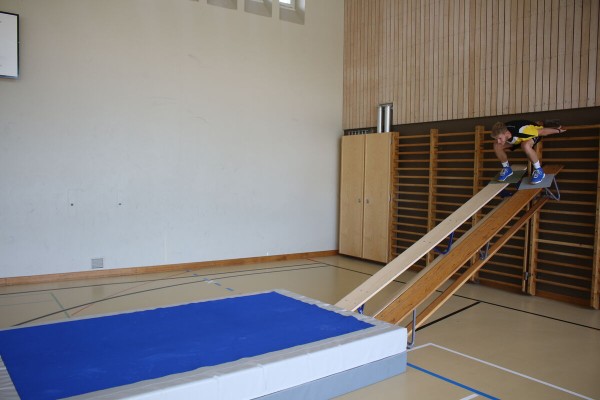
Stand on carpet remnants in a squat position at the top of the long benches (one foot per long bench). Hold on to the wall bars backwards and slide down in a squat position. At the end of the long bench, jump off in a ski jumping position (stretched body) and land on the soft mat.
Variant:
Change the steepness of the run-up.
►Balance, orientation and reaction skills
1 wall bars
2 long benches
2 Tepich rests
1 soft mat (large)
Post setup:
Hook two long benches to one side of the wall bars (at a height of approx. 1.5m). Place a large soft mat in front of the long benches.